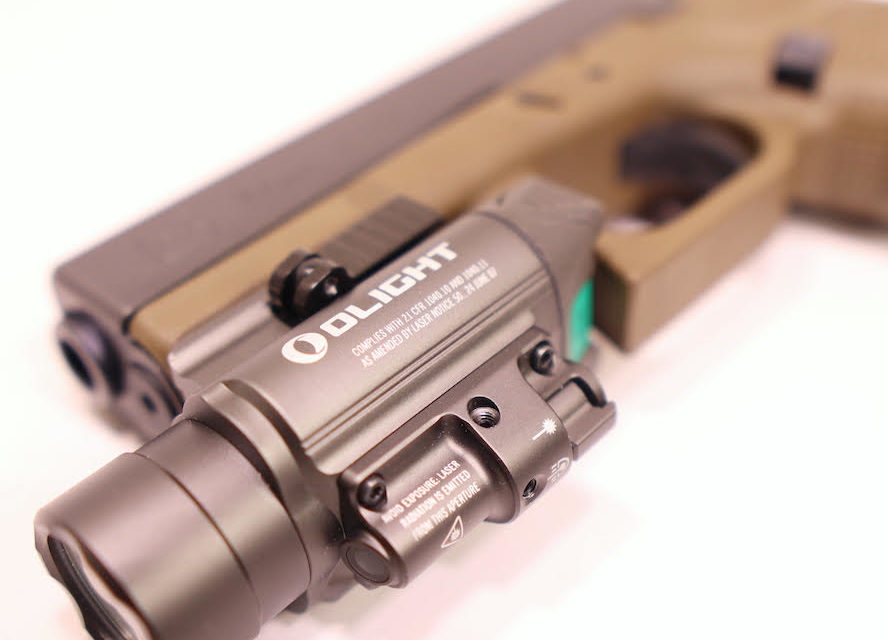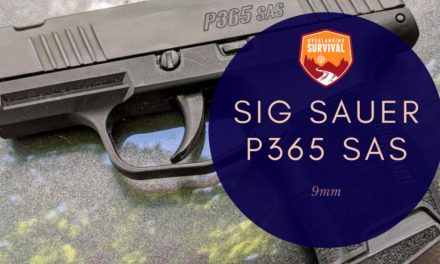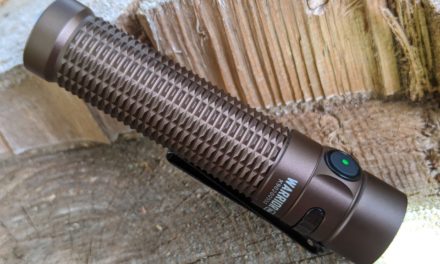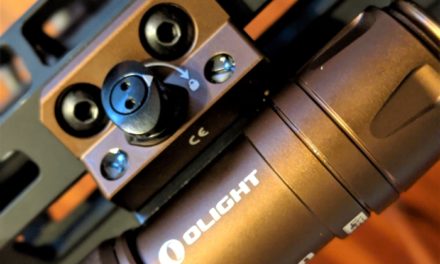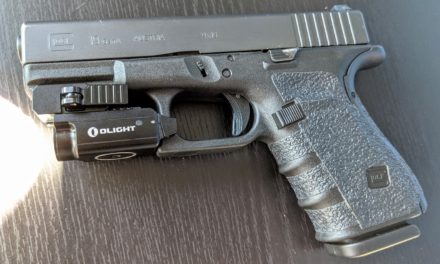By Doc Montana
Ever since the first creative soul duct taped a Maglite to a shotgun barrel, man has been on a relentless quest for the perfect weapon light. Sure, there were early attempts with oil lamps and wax candles, but that was pure novelty. The first few decades of the modern gun light primordial stew was nothing but alkaline batteries and incandescent bulbs. Evolution was painfully slow ensuring that weapon-mounted lights were little more than a novelty. Even though the first patent for a gun light was granted only 14 years after the invention of the flashlight, Occasionally there would be a punctuated advance in evolution after some new discovery in batteries or inert gas inside a lightbulb. But for a weapon light to ever catch the eye and tap the wallet of the average shooter, something dramatic had to happen.
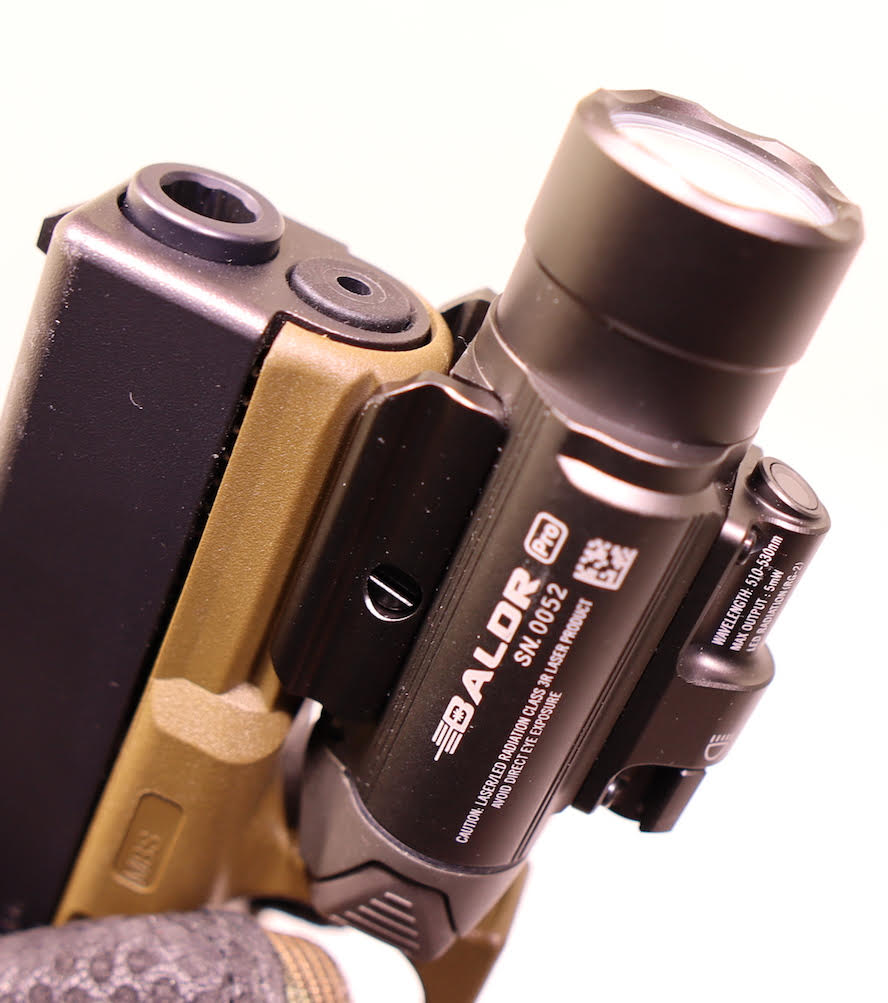
Just two short decades ago, we were thrilled to get our 20 minutes of 120 lumen gun light as the hot and fragile incandescent bulb chewed through a pair of CR123 batteries like candy. At the time, using the light cost about a buck a minute in electrons. Compare that to the small handful of dirty yellow lumens we got from the old D-cell flashlights, assuming the batteries hadn’t yet corroded. And don’t get me started on the massive dark spot in the middle of the beam.
Dogpile
When a new technology kid did show up on the block, the different light makers would quickly converge into similar form and function each new model adapting and mutating according to advantages of the new tech, constrained only by the narrow halls of the patent office.
Today, light emitting diodes (LED) and Lithium batteries have solved nearly all the issues that plagued gun-mounted lights. Once we dumped Thomas Edison’s wiggling filaments and Rayovac carbon-filled D-cells, the numbers we use to measure portable lighting increased by magnitudes. Literally adding zeros to the lumens and runtime. Now the choices between models are more refined with focus on mounting, operation, features, lasers and of course, price. Enter the Olight Baldr Pro.
In Norse mythology Baldr is is the god of light, joy, purity, and the summer sun. So one can only assume that Baldr Pro is the god of light etc. on steroids. So any weapon light named after a professional level Baldr must rise to a standard higher than the average god.
The Olight Baldr Pro weapon light is an exceptional choice both in performance and value. In fact, there is no downside to this light. Just design decisions. My weapon light tastes ran towards Surefire for raw light, and Streamlight when a laser was involved. The build quality of the Surefires was top shelf, and it had the price to prove it. But my dabbles with Surefire’s light/laser combo left me wanting. It was clunky and operated and felt like the engineers just bolted a laser onto their light with little discussion. Streamlight was a strong second place in attention to material detail but insisted on a primitive clamp design for its rail mount. One did not need a degree in genetics to know that the evolution of weapon lights was far from apex predator status.
Further sealing this deal is the IPX4 rating meaning this Baldr Pro means it has an ingress protection (IP) level four resistance to water translating to splashing water from any direction. So don’t submerge it or spray it with pressurized water. If you can avoid dropping your pistol in the swimming pool, or have no plans to engage an enemy wielding a firehose, then you’ll be fine.
Too much should be enough
At a rated 1350 lumens, the Baldr Pro lands on the high end of low profile pistol-rail mounted lights. In fact it is more than double the lumens of many others at its price point. Pushing over a thousand lumens out the front door, anything falling into the Baldr’s circle of influence will find its night turned into day.
The Olight Baldr Pro has a top speed of 186,000 miles per second, and can run out to 853 feet instainiously. Its 1350 lumens really will blind you, and for smaller areas, you can downshift the Baldr Pro to a paltry 300 lumens which was on its own a world-class amount of horsepower just a few years back.
Runtime is impressive with a full minute of 1.3k lumens before beginning the downhill slide to a respectable 500 lumens. And that slide lasts up to two hours. At the lower output setting, the Olight Baldr Pro can shove photons down the pipe for nearly four hours. Add the laser to the mix and either output will be reduced by essentially not much.
And it’s not just the amount of light, but the color of light. The term white light gets tossed around, but only recently have affordable LED light produced anything close to white. Most were greenish or yellowish. The Baldr Pro produces a nice bright white light that doesn’t change the color of objects or foliage. But don’t take my word for it, here’s the spectrograph from my spectrometer. What, you don’t have your own spectrometer?
Previous or inexpensive LED lights lean heavily just in the blueish range of wavelengths. Full spectrum, or white light LEDs, blend the blue with the brighter greens, yellows and a touch of red. What that means in weapon lights is unless the target is wearing a turquoise colored jacket, there is a good chance you will see the colors as they would under sunlight.
Make mine a double
Modern lighting tools have not escaped Moore’s Law. And the Olight Baldr Pro is further proof. But raw light energy is just the beginning. To safely and effectively operate all that power, the user must be able to control the light quickly, accurately, and instinctively. Creative switch designs and complicated interfaces are nothing but trouble. Even small details can cause delays and mistakes especially when milliseconds count.
Also Read: Olight Warrior Mini Review
The Baldr Pro has two push switches and one toggle lever. The push switches do exactly what you expect, exactly how you expect. Push and release either one and the Olight Baldr Pro turns on (or off it was already on). And by on, that could mean the light only, the laser only, or both, all depending on the position of the toggle switch. And unlike some other weapon lights, the Baldr Pro’s three-position toggle is left for laser, and right for light. The center portion is both laser and light as it should be.
The humble tail switch still has a few tricks up its sleeve. “On” and “off” are relative terms here. If you push and release the switch, the light stays on. If you push and hold the switch, the light only remains on as long as the switch is held in. If you double click the switch, the light toggles between the two brightness settings. The memory of the light will return to the last brightness setting next time. And if you push both switches at the same time, the light will strobe with any button push shutting it off and there’s no memory for the strobe.
Connect the Dot
Laser light is a unique phenomenon not found in nature. Its coherent beam of light is both of one wavelength and all in phase. This keeps the photons behaving as they fly out to obscene distances. The magic of a laser on a gun is that when properly sighted in, the laser marks the point of impact. That means pretty much everything about the rest of the gun is meaningless when it comes to aiming. Your eyeball does not need to be anywhere close to the firearm to line up the muzzle with the target. The only catch is you have to be able to see the laser light.
Although Arnold (The Terminator) was able to walk into his local gun store in 1984 and pick up a .45 long slide with laser sighting, the rest of us had to wait a decade before lasers became a realistic option. Although the gun shop owner did admit to Arnold just before being dispatched, “Those are new. We just got them in.”
The first weapon lasers were red. It was a lower power, longer wavelength dot of light that was hard to see in daylight, and blended into many other colors as it painted the target. Green, on the other hand, is a color the human eye is specially designed to see quickly. I’m not sure why, but like a baby crying, or a mosquito buzzing to our ears, our eyes are unusually quick to discern a green dot from a colorful background. And when painting dark objects, the green laser is near blindingly bright.
The only downfall for shooters (but a boon for astronomers) is that water molecules also have a particular affinity for the specific green wavelength used in lasers. Over distance, the beam of a green laser becomes visible through the air even in the absence of dust. That unique property of green laser light and water vapor gives the Hollywood effect that must be added artificially with red lasers. That famous effect is the Star Wars light saber-like beam swinging around from gun to infinity. The fear is that the enemy will attack the source of the laser. I’m not concerned, but your mileage may vary.
The advantage of using laser sight is somewhere between essential and extreme. It can be used or ignored on the fly. It has an infinite range and thanks again to Hollywood, an unmistakable message attached to the far end of the beam. The instructions for use are simple, and the results are just as deadly. However, there are some drawbacks to lasers. First, they paint a dot on the target, which is their point (pun intended), so that makes them illegal to hunt with in many circumstances.
Lasers also require the eyesight and concentration to place and locate the dot making them near impossible to use on moving targets. Even more, the laser can only be seen when reflected back so they interact with the surface they hit. A stop sign at a hundred yards becomes a mini-sun. Shiny or smooth surfaces may send the beam off in a different direction like a mirror. And dark textured surfaces like a wool coat may drastically reduce the amount of light reflecting back towards the source. Red dot sights, on the other hand, superimpose a red dot over the target so no actual contact with the target is needed no matter how light (again, pun intended).
Mount Up!
Hanging out near the muzzle of a firearm is not a place for the weak. So the Olight Baldr Pro is more durable than most. The glass lens on the main light barrel is more than enough to protect the total internal reflectance (TIR) housing surrounding the LED. The laser too has a glass cover. But there’s no point in splitting hairs with durability if the light won’t stay put.
It seems evolution is still happily at work with weapon light mounting options. For comparison, the Surefire x300 Ultra has a spring loaded retractable bar that locks into a rail slot. Nice idea, but the two main faults I have with that design are, first, because the rail-grabbing sides of the mount are immobile, the light must be slid onto the rail, and then positioned. This can be a hassle when moving the light around, and may even require removal of other rail components to install the light. And number two is that I routinely activate the light while installing, moving , or dismounting it.
The Streamlight does have the ability to open its jaws and grab a rail at any point, but uses a screw fastener requiring a driver to snug it to the rail. Now that driver could easily be a coin, but still, it is a hassle, and I did notice some loosening over time.
The Olight Baldr Pro, on the other hand, uses a standard and proven quick release lever. The rail jaws expand and contract with the lever position making a rapid attachment or removal pretty much a non-issue. The Baldr Pro comes with an additional rail bar to substitute for the generic Glock one. Extra screws and threaded inserts for the laser adjustments are also included.
The Olight Baldr Pro represents the next generation of consumer weapon light. If you have an old light, it’s time to upgrade. If you don’t have a light, now is the time to get one. There is simply no reason to wait especially with the sales that Olight is offering.

